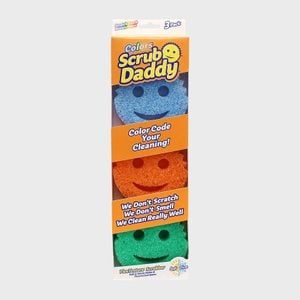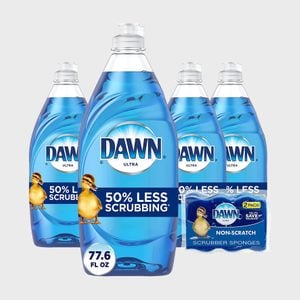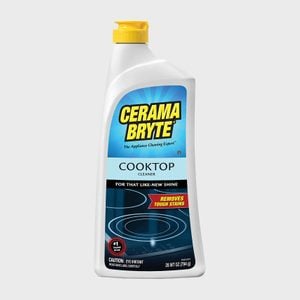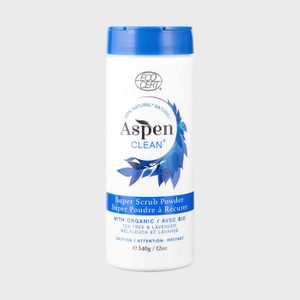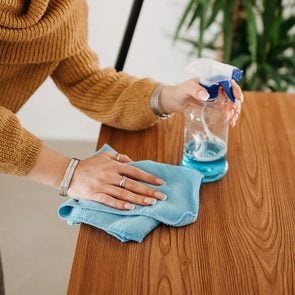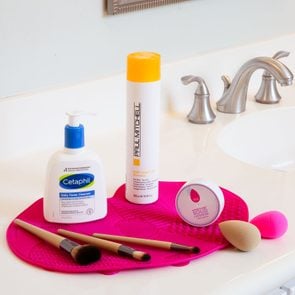How to Clean an Electric Stovetop Quickly and Easily
Updated: Jun. 02, 2024

Don't let burnt-on food get you down. Learn how to clean an electric stovetop and get yours shining in no time.
Our editors and experts handpick every product we feature. We may earn a commission from your purchases.Learn more.
Do you cook with electric or gas? If you’re like nearly 70% of cooks in the U.S., your answer is electric. That’s a lot of people who need to know how to clean an electric stovetop. Luckily, it doesn’t take much to keep your burners clean once you’ve got them shining.
Cleaning an electric stovetop depends on the type you have, says Alicia Sokolowski, co-CEO of AspenClean. Thanks to their smooth, sleek surfaces, both induction stovetops and glass stovetops should simply be wiped down with natural cleaners, an easy addition to a regular cleaning schedule. Electric stovetops with burners and drip pans take a little more effort, says Sokolowski, but nothing you can’t handle. How to clean your kitchen from top to bottom should always include regular cleaning for household appliances, including dishwashers, microwaves, refrigerators and stovetops, and knowing how to clean your oven. Not only will these how-to-clean tips help to fight stovetop grime and bacteria, they’ll also ensure a more efficient and durable appliance.
Get Reader’s Digest’s Read Up newsletter for more cleaning, humor, travel, tech and fun facts all week long.
How to clean an electric stovetop
Here’s a housecleaning tip: Clean your oven, oven racks and stovetops on the same kitchen-cleaning day. Both glass and traditional electric stoves can be cleaned the same way, according to Sokolowski. But there is one major caveat: “The main difference is that you will clean the coils and drip pans separately.” If you have a stove with burners and drip pans, clean those first before following the steps for how to clean an electric stovetop.
Supplies:
- White vinegar
- Spray bottle
- Baking soda
- Dish towel or bath towel
- Microfiber cloth
- Stovetop cleaner
- Disposable gloves (optional)
Directions:
1. Prepare with vinegar
Make a half-and-half mixture of white vinegar and warm water in a spray bottle. Spray the surface of your glass electric stove with the vinegar mixture, and wipe with a microfiber cloth.
2. Spread baking soda
Fill your kitchen sink with hot water and submerge a clean bath towel or kitchen towel in it. Scatter baking soda all over the surface of the electric stovetop, then grab the towel from your sink. Wring it out well, lay it over the baking soda and wait 15 minutes.
3. Scrub
Remove the towel and scrub the stovetop until all the baking soda is gone. Sokolowski says to apply gentle pressure on glass stovetops. “A light touch is always better,” she says, as replacing a cracked glass stovetop will be a bit more challenging. If stuck-on messes still persist, add more baking soda and repeat this step.
4. Wipe down
Spray the stovetop with vinegar and wipe with a microfiber cloth. When complete, use a dry microfiber cloth to buff and shine the stovetop.
Pro tip:
Don’t try to use vinegar and baking soda at the same time, like the papier-mâché volcano you built in grade school. While this makes a great big bubbling mess, Sokolowski says it’s not the best way to clean your stove. Save this concoction to deodorize your garbage disposal. You can also use a natural, all-purpose cleaner or stovetop cleaner instead of vinegar on electric stoves, but don’t use commercial glass cleaners, like Windex, on glass stovetops. There are things you should never clean with Windex, and this is one of them. Most Windex products contain ammonia, which is too harsh for glass stovetops, Sokolowski says.
How to clean electric stove coils
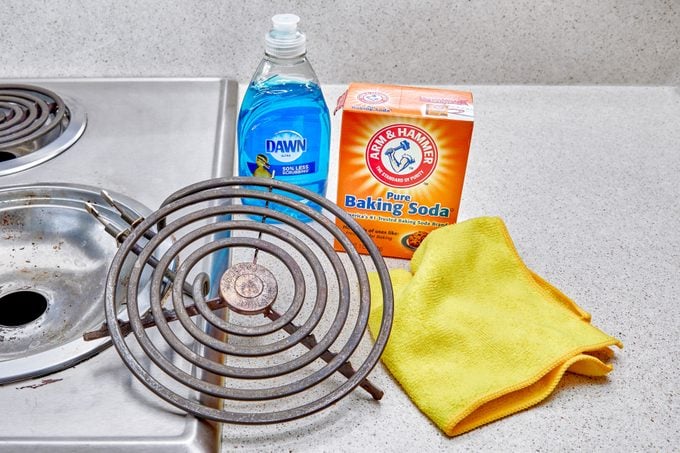
The coils (or burners) on traditional electric stoves have a positive going for them, says Sokolowski—they’re basically self-cleaning. Simply turning them on burns off most stuck-on food. However, for best results, there are a couple more steps and an important warning: “Do not let spark igniters, wires, switches or any other electrical controls or parts get wet,” she says. At the minimum, you risk damaging them. Worst-case scenario? You could spark a fire or short circuit.
Supplies:
- Baking soda
- Dish soap
- Microfiber cloth
Directions:
1. Prepare
Remove everything from your electric stovetop and coils. With the stove off, wipe the coils with a damp microfiber cloth.
2. Turn the coils on
Turn your burners on high for two to three minutes. Let them get red-hot, watching them the entire time for safety (keep kids and pets away). If the burners are really dirty, turn on the vent hood, if you have one, to clean the air of smoke. (Next project: how to clean an oven hood.) Let the high heat burn off any food residue that’s stuck to the burners, then let them cool down completely.
3. Clean the coils
Remove the burners and brush off the ash in the sink or over the garbage. Load a microfiber cloth with hot, soapy water; wring out the excess moisture. Scrub the burners, then wipe clean with a fresh (non-soapy) microfiber cloth. Never submerge your burners in water, and keep the socket where the burner connects to the stove from getting wet—electricity and water do not mix.
4. Clean the stovetop
Most electric stovetops with coils allow you to lift up the top to clean underneath, where crumbs and spills fall below the drip pans. Use the same vinegar and baking soda technique as above to clean underneath the stovetop as you do the top surface, and make sure to wring out most of the water from towels and microfiber cloths when using them on your electric stove.
Pro tip:
High heat should take care of most stuck-on food. If any stubborn grime remains, make a paste with 1/2 cup of baking soda and 3 to 4 tablespoons of warm water. Coat the coils with the paste and leave them for 20 minutes. Wipe with a damp microfiber cloth to remove the baking soda residue, rinsing your microfiber cloth periodically.
How to clean electric stove drip pans
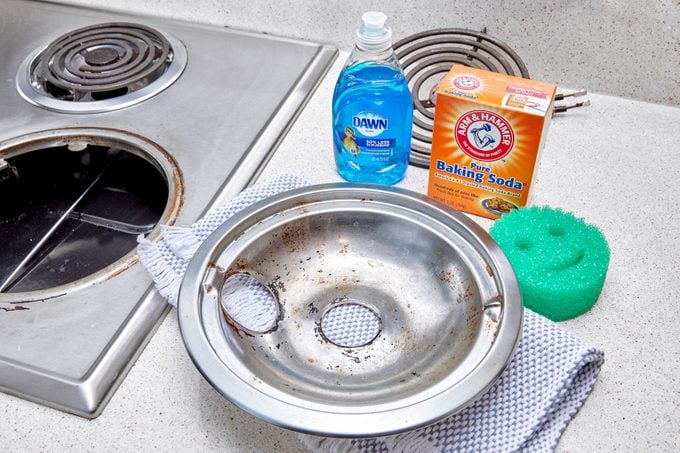
Drip pans collect crumbs and spills from cooking mishaps and often take the brunt of grime. After all, you generally wipe down the stovetop after cooking a messy meal, but how often do you take out the drip pans and clean them? Sokolowski walks us through how to clean stove drip pans below.
Supplies:
- Baking soda
- Dish soap
- Dish towel
- Sponge or scrub brush
Directions:
1. Remove drip pans
Take the drip pans out of the stovetop and shake them into the garbage to remove excess crumbs. Take them over to your sink and rinse them with hot water.
2. Scrub
Add baking soda to the drip pans. Load up a wet sponge with dish soap and squeeze to get some lather going. Rub the baking soda into the pans with the soapy sponge, then leave them for an hour.
3. Scrub again
After the baking-soda-and-soap paste has had time to loosen the stuck-on food and grease, rinse them in hot water. Rinse your sponge, add fresh baking soda and start scrubbing again. Rinse one final time with hot water and dry with a dish towel.
Pro tip:
Baking soda has a mild, basic pH and gentle-but-abrasive properties, which works wonders on all sorts of grime. There are plenty of brilliant baking soda uses around the house (cleaning glass shower doors! removing burn marks from an iron!), but in the kitchen, it’s ideal to clean cutting boards, scrub burnt pots, clean a dishwasher, clean a coffee maker, deodorize a garbage disposal and much more.
How to get burn marks off a stove
We’ve all been there: A pot boils over and we don’t clean it right away. Then, we cook something else, making that once easy-to-remove stain a seemingly permanent part of the stove’s surface. Baking soda again gets the nod for these tough stains, but for glass stoves in particular, you can also employ a special tool: the razor blade scraper.
Supplies:
- Baking soda
- Microfiber cloth
- Razor blade scraper (glass stovetops only)
Directions:
1. Make a paste
Mix 1/2 cup of baking soda and 3 to 4 tablespoons of warm water. Apply a little baking soda paste onto burn marks.
2. Use a razor (glass stovetops only)
Holding the razor blade scraper at a 45-degree angle, work the scraper under the burnt-on residue until it flakes away. Use gentle, even motions, and keep the razor blade angled to prevent scratching your glass stovetop. For electric stoves with an enameled metal surface, skip this step, as razors can mar the surface.
3. Wipe away
Once the baking soda paste has worked its magic, wipe away the paste and burn residues with a damp microfiber cloth.
The best electric stove cleaners
How to keep an electric stove clean
Now that you know how to clean an electric stovetop, you’ll want to keep it clean. Wiping up spills when they’re fresh is the best way to do this. Wait until the stove cools down and all burners are off, then wipe with a damp cloth or sponge. If spills have set a little too long, spray with the vinegar solution or an all-purpose cleaner, and wipe clean. Sokolowski recommends using natural cleaners only, but check your owner’s manual for any specific recommendations for cleaning your electric stovetop. It’s possible cooking and cleaning mishaps might not be covered under warranty, so do your due diligence.
With electric stovetops, you’ll also want to be extra careful to avoid spillovers, especially with sugary foods that stick to glass like glue. To avoid permanent damage on glass, GE Appliances suggests immediately scraping the sugary spill onto a cold area of the glass stovetop using a razor blade. Wipe it up with a sponge or microfiber cloth.
Sources:
- Alicia Sokolowski, president and co-CEO of AspenClean
- GE Appliances: “Glass Cooktop Cleaning Instructions”
- Statista: “Electric or Gas? What the U.S. Is Cooking On”




















